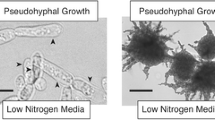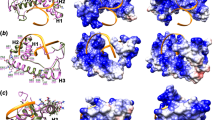Abstract
Diploid strains of S. cerevisiae are known to develop pseudohyphae in response to starvation for nitrogen. We report that both haploid and diploid yeast grow in a filamentous form when embedded in solid media. This is not a response to starvation, since yeast grown on rich media and overlaid with rich agar grow within the agar as pseudohyphae. While we find that the only element of diploidy required for formation of pseudohyphae in response to nitrogen starvation is the a1/α2 repressor, pseudohyphal development by embedded cells does not require a1/α2. Deletion of BUD 5 prevented the formation of pseudohyphae by embedded cells, suggesting that these structures are the result of ordered filament formation rather than agar penetration. Deletion of STE 12 prevented the formation of pseudohyphae by all cell types, showing that the same signal transduction pathway is used by embedded cells as by those responding to nitrogen starvation. Different cell types of yeast thus form filaments in response to several kinds of environmental stimuli.
Similar content being viewed by others
Author information
Authors and Affiliations
Additional information
Received: 13 March / 7 May 1997
Rights and permissions
About this article
Cite this article
Lo, WS., Raitses, E. & Dranginis, A. Development of pseudohyphae by embedded haploid and diploid yeast. Curr Genet 32, 197–202 (1997). https://doi.org/10.1007/s002940050266
Issue Date:
DOI: https://doi.org/10.1007/s002940050266




